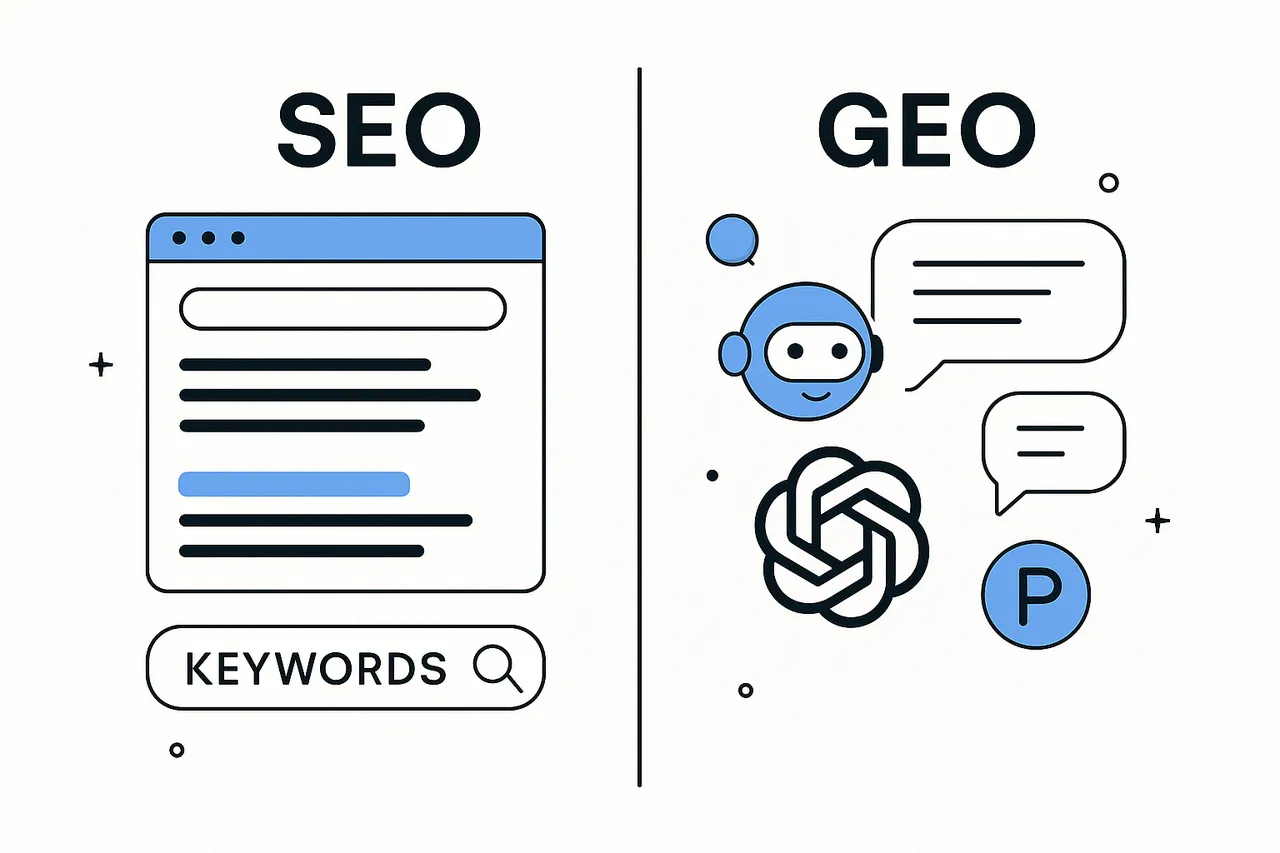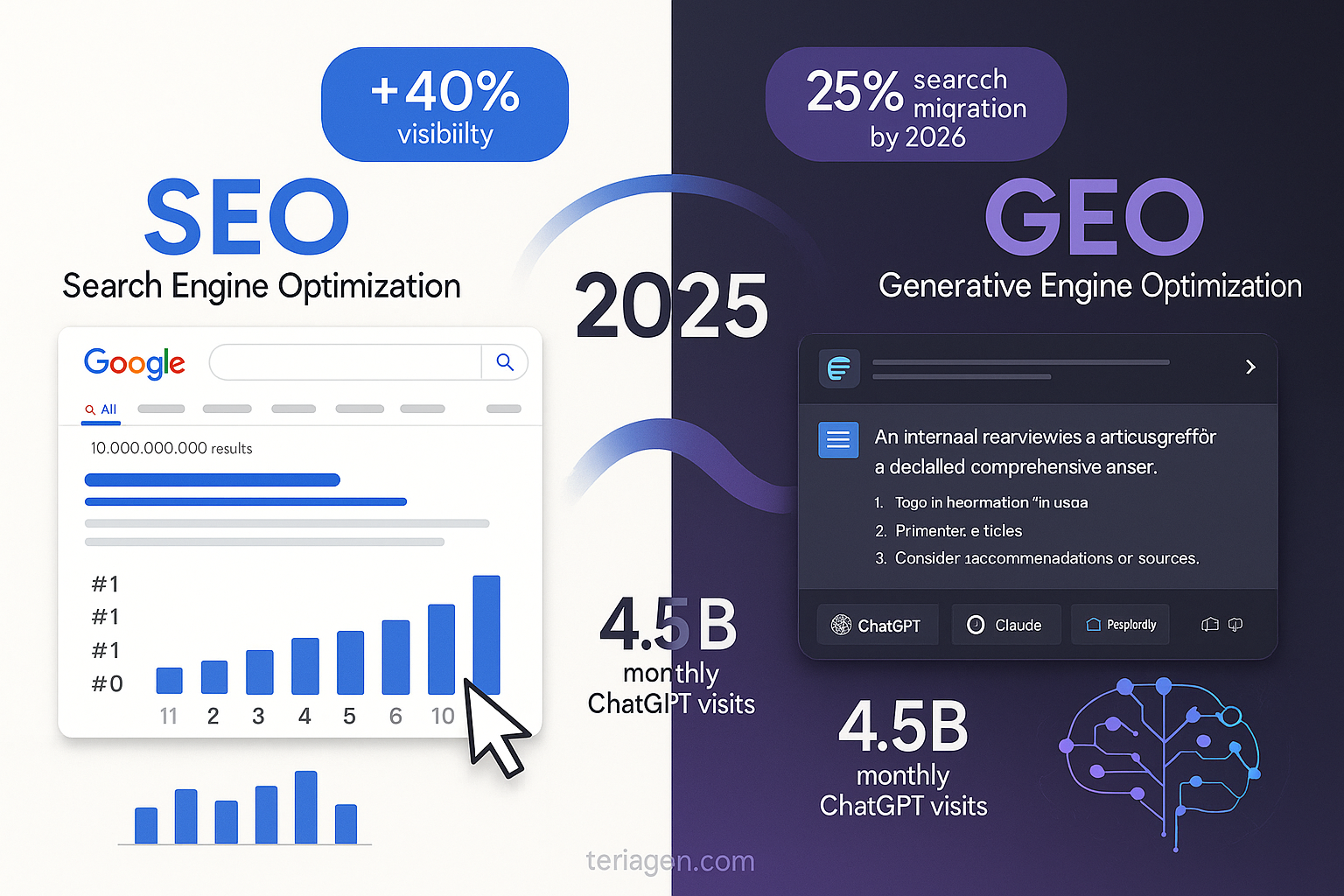For the past few months, a new term has been making its way into the digital world: GEO, short for Generative Engine Optimization.
At first glance, it might look like yet another miracle method for visibility — a new promise of ranking success in a world where ChatGPT, Gemini, and Perplexity are taking an ever-growing place in information search.
But GEO is neither a trend nor a traditional technological revolution.
It’s a logical evolution of SEO, born from the way search engines now rely on generative AI to craft their answers.
And that’s precisely where the misunderstanding lies: many believe that GEO replaces SEO.
In reality, it complements it.
And for businesses, understanding the difference between these two approaches is absolutely essential.
GEO: what are we really talking about?
GEO (Generative Engine Optimization) refers to the set of practices designed to optimize the visibility of your content within the results produced by generative AI search engines whether it’s Google’s AI Overviews, Perplexity summaries, citations integrated into ChatGPT, or any other interface capable of generating synthetic answers from online sources.
The goal is no longer just to appear in the traditional SERP, but also within the AI-generated responses.
These answers no longer simply list links — they summarize, prioritize, and contextualize information.
For brands, this changes everything:
it’s no longer enough to be well ranked;
you now need to be understood, recognized, and cited by AI models.
In other words, GEO is not a competing technology to SEO, but an extension of its scope and purpose.

The Myth of Replacement: Why GEO Doesn’t Kill SEO
Some claim that SEO is becoming obsolete doomed to disappear in the face of artificial intelligence.
That’s simply not true.
Traditional SEO still relies on four key pillars:
- Technical: ensuring the website is accessible, fast, and well-structured.
- Content: producing rich, relevant text aligned with search intent.
- Authority: strengthening credibility through links, citations, and reputation.
- User experience: ensuring smooth navigation and a coherent interaction.
None of these fundamentals are outdated.
Generative AI actually depends on these very quality signals to identify trustworthy content to include in its responses.
In other words: without solid SEO, there can be no effective GEO.
GEO doesn’t erase the foundations of search optimization — it extends them.
Where SEO focuses on indexing bots and SERP ranking, GEO focuses on generation systems and interpretation models.
What Generative AI Really Changes for SEO
The integration of AI into search profoundly changes how visibility is distributed.
Until now, SEO operated on a linear model: one query → one list of links.
Now, AI provides a written, synthesized answer, often without requiring the user to click.
This means two major shifts:
- Organic click volume may decrease.
- Source mentions (citations) become strategically valuable.
In practical terms, optimization is no longer just about ranking a page, but about making content identifiable and reusable by a generative search engine.
Example:
An article structured with clear headings, concise paragraphs, and verifiable data is far more likely to be selected and quoted by an AI model than content that’s verbose or poorly organized.
GEO: a strategic lever, not a miracle method
GEO doesn’t rely on “tricks” or technical shortcuts.
It is above all a strategic approach, requiring a deep understanding of the interactions between content, AI, and search engines.
Concrete levers include:
- Structuring content so it can be interpreted by AI (clear headings, consistent tags, structured data).
- Adopting a conversational tone: AI favors content that naturally answers questions.
- Strengthening brand legitimacy: generative models give more weight to recognized and reliable sources.
- Ensuring semantic clarity: avoid ambiguous phrasing and enrich the lexical field.
The goal is not to write “for AI,” but to make content readable for both humans and generative models.
How we support our clients in this transition
At our company, we see GEO as a natural extension of SEO strategy.
Our teams combine technical expertise, editorial approach, and strategic vision to help brands stay ahead in the AI + search ecosystem.
Our support is organized into three steps:
1. SEO + GEO Audit
We analyze current site performance, content structure, and the way search engines interpret your pages.
→ Objective: identify content that can be highlighted in generative responses.
2. Optimization and Structuring
We refine content to make it more understandable by AI: logical hierarchy, enriched data, Q&A formats, semantic consistency.
→ Objective: increase automatic recognition and citation of your brand.
3. Monitoring and Strategic Management
We measure the impact of GEO on visibility, traffic, and brand reputation to continuously adjust levers.
→ Objective: turn GEO into a tangible marketing and differentiation lever.
The challenge for decision-makers: anticipate, don’t react
GEO is not a passing trend.
It is the natural adaptation of SEO to a new way of searching, reading, and consuming information.
Companies that anticipate this shift today will gain a decisive advantage. They will have:
- Content better understood by AI, and therefore cited more often.
- Better control of their image in generative answers.
- A resilient SEO strategy in the face of evolving search engines.
On the other hand, ignoring GEO risks losing visibility in environments where users no longer necessarily see the traditional results page, but a synthesized AI-generated answer.

Conclusion: SEO + GEO, the winning combination
GEO is not a replacement, but a strategic extension of SEO.
It is by combining these two approaches that companies can maintain their visibility and authority in the era of AI-augmented search.
We firmly believe that content remains key, but its structure, intent, and reliability must evolve with user behavior.
Our mission is to help brands navigate this shift with clarity and method, turning technology into a sustainable competitive advantage.
Curious and creative, she loves to dive deep into brands to uncover their true essence — through words, visuals, and bold ideas. For her, great content is the one that makes people react, think, or smile.



